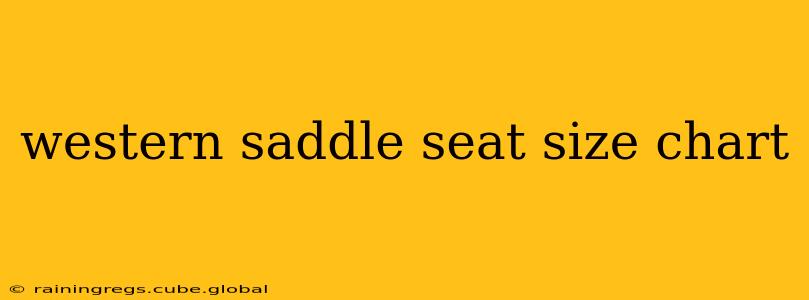Choosing the right western saddle is crucial for comfort, safety, and performance. A poorly fitting saddle can lead to discomfort for both horse and rider, potentially causing injuries and hindering riding ability. Understanding western saddle seat sizes is the first step in finding the perfect match. This guide will break down western saddle seat sizing, addressing common questions and offering valuable insights.
What are the Standard Western Saddle Seat Sizes?
Western saddles come in a range of seat sizes, typically measured in inches. The most common seat sizes are 13", 14", 15", 16", 17", and 18". However, you can find saddles with smaller or larger seats depending on the manufacturer and saddle type. The seat size refers to the measurement across the widest part of the saddle seat, from one cantle to the other.
It's important to note that the seat size isn't the only factor determining saddle fit. Other crucial elements include the tree size (which relates to the horse's build), the gullet width (the space between the saddle bars), and the overall saddle design.
How Do I Determine My Correct Western Saddle Seat Size?
Your ideal western saddle seat size is closely tied to your body size and riding style. While there's no universally accepted formula, here's a general guideline:
- Smaller Riders (under 5'4"): Often prefer saddles with 13" to 15" seats.
- Average Riders (5'4" to 5'8"): Typically find comfort in 15" to 16" seats.
- Larger Riders (over 5'8"): May require saddles with 16" to 18" seats.
However, these are just estimations. The best way to determine your ideal seat size is to try out different saddles. Pay close attention to how comfortable you feel and how well the saddle allows you to maintain a balanced posture.
What is the Difference Between a Full Quarter Horse Bar and a Semi-Quarter Horse Bar?
The terms "full quarter horse bar" and "semi-quarter horse bar" refer to the shape and width of the saddle tree, which significantly influences the saddle's fit on the horse. A full quarter horse bar is designed for horses with a broader, more muscular build, offering more stability and support. A semi-quarter horse bar is a narrower option better suited for horses with a more slender build. Choosing the correct bar type is critical for your horse's comfort and prevents pressure points.
Does My Weight Influence Saddle Seat Size?
Your weight plays a less significant role in determining the saddle seat size compared to your height and build. The seat size primarily affects your comfort and ability to maintain proper posture. However, a heavier rider might consider a more robust saddle overall, regardless of the seat size, ensuring the saddle's construction can handle the added weight.
How Important is the Saddle's Gullet Measurement?
The gullet measurement is arguably even more important than the seat size when it comes to a proper fit. The gullet is the opening between the saddle bars, and its width must match your horse's withers (the highest point of the horse's shoulders) to avoid pressure points and ensure comfort. An incorrectly sized gullet can lead to discomfort and potential injury for your horse. This requires professional fitting for accuracy.
Are There Different Seat Sizes for Women's Western Saddles?
While there isn't a separate "women's" seat size chart, women's western saddles often focus on comfort and ergonomics tailored to a female rider's build. This might involve a slightly different seat shape or design features, but the seat size remains measured the same way as men's saddles. Ultimately, comfort and fit take precedence over gendered sizing.
Where Can I Find More Information on Western Saddle Fitting?
Finding a qualified saddle fitter is crucial for both you and your horse. A professional fitter can assess your body type, riding style, and your horse's conformation to recommend the perfect saddle and ensure proper fit. Local tack shops or equestrian associations can often provide referrals to experienced saddle fitters. Invest in professional fitting for long-term comfort and injury prevention.
This information should serve as a helpful starting point, but remember that professional advice is essential for finding the perfect western saddle and seat size. Prioritizing comfort and safety for both yourself and your horse is paramount to a positive riding experience.
